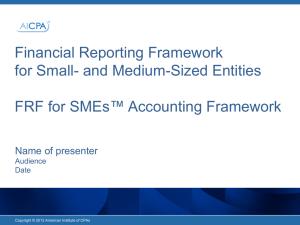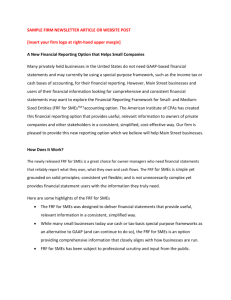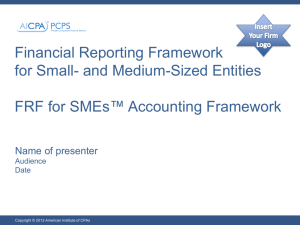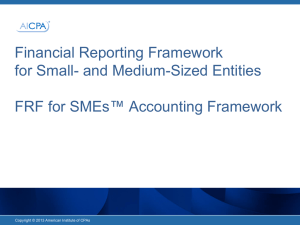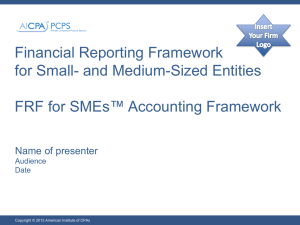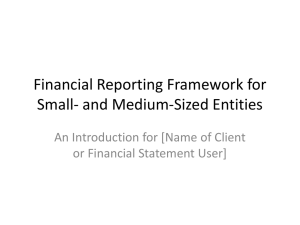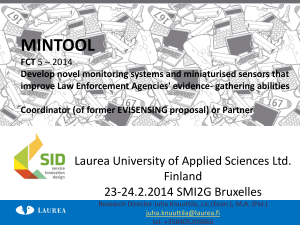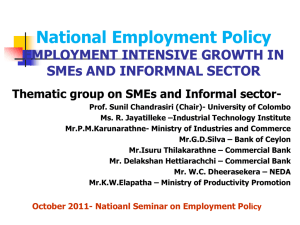FRF for SMEs™ PowerPoint to Introduce Framework to Staff
advertisement
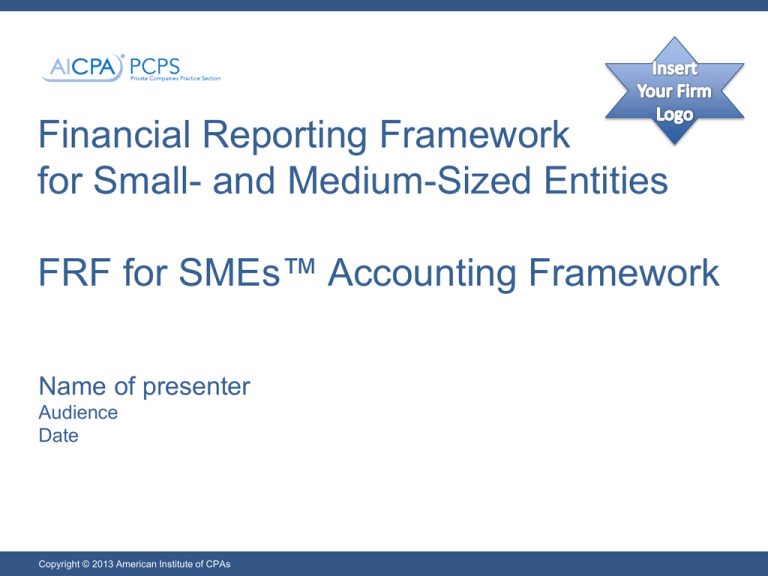
Financial Reporting Framework for Small- and Medium-Sized Entities FRF for SMEs™ Accounting Framework Name of presenter Audience Date Copyright © 2013 American Institute of CPAs Instructions To Firms Below are some suggestions when using this PowerPoint to introduce your team members to the FRF for SMEs Framework • This PowerPoint is an overview of the framework. Reviewing this is not a substitute for reading and understanding the actual guidance. • Several slides have a comment note for you to consider based on your processes or to consider incorporating relevant examples. • To make this most useful for your team, look for other points within the presentation where you have relevant examples or experiences. Once you have tailored this PowerPoint to your firm’s current practices, delete this slide and the other red notes you’ll find in the following slides. Private Companies Practice Section 2 Current Special Purpose Financial Reporting Framework Environment Small and medium-sized entities (SMEs) may not need GAAP-based financials If GAAP isn’t required, a special purpose framework may be the financial reporting option currently used • • • • Tax Cash Regulatory Contractual Special Purpose Framework is the term that replaces OCBOA Private Companies Practice Section A New Non-GAAP Special Purpose Financial Reporting Framework AICPA has released the Financial Reporting Framework for SMEs • Non-GAAP • Streamlined • Based on traditional and proven accounting methods • Provides meaningful financial reports without needless complexity Private Companies Practice Section An Additional non-GAAP Framework Private Companies Practice Section Separate from FAF and Private Company Council Private Company Council Is GAAP Modifies GAAP for private companies FRF for SMEs Not GAAP - Special Purpose Framework Is developed specifically for private small businesses Complementary to efforts by FAF’s PCC Private Companies Practice Section Useful Resources Financial Reporting Framework for Small- and Medium-Sized Entities An Introduction to the Financial Reporting Framework for Small- and Medium-Sized Entities Comparison of FRF for SMEs to Other Bases of Accounting Illustrative Financial Statements Illustrations of the Application of Certain Principles and Criteria www.aicpa.org/FRF-SMEs Private Companies Practice Section What entities may want to use FRF for SMEs? Owner-managed – closely held For-profit No regulatory reporting requirements that essentially require GAAP-based financial statements No intention of going public Not in an industry that requires highly-specialized accounting guidance, such as financial institutions and governmental entities Does not have overly complicated transactions Does not have significant foreign operations Key users of the financials have direct access to the entity’s management Private Companies Practice Section Authority and effective date Use of the framework is purely optional The AICPA has no authority to require the use of the FRF for SMEs accounting framework for any entity Management represents that such financial statements have been prepared in accordance with the AICPA’s FRF for SMEs accounting framework, a special purpose frame-work Because use of the framework is optional, there is no effective date for its implementation Private Companies Practice Section Advantages of FRF for SMEs The framework is concise and self-contained. The framework will be stable. • Frequent changes to the framework are not expected. Financial statements will more closely align with income tax returns because there will be fewer book-to-tax adjustments. Private Companies Practice Section Advantages of FRF for SMEs Historical cost is the primary measurement basis • Avoids complicated fair value measurements. Accounting policy options will allow management to select what is best for their purposes • Example - current taxes payable method or the deferred tax method Goodwill is amortized over the same period as for federal tax purposes. • No impairment testing is required Private Companies Practice Section Advantages of FRF for SMEs Only relevant principles are included and the accounting is simplified. • Accounting for long-lived assets follows an amortized/depreciated cost approach. - No impairment testing is required • No other comprehensive income (OCI) • No variable interest entities (VIEs). Parent-only financial statements are allowed • No complicated accounting for stock compensation and derivatives • No hedge accounting Disclosures are targeted to small business issues. Private Companies Practice Section Advantages of FRF for SMEs FIRM: Note your new disclosure checklist process for engagements using FRF for SMEs. Targeted Disclosures Disclosures are streamlined to avoid excess detail, complexity, and extraneous information If a user requires additional information, management can tailor the nature and extent of disclosures to suit those needs Private Companies Practice Section A Look at Key Principles of FRF for SMEs Primarily uses historical cost basis • Avoids complicated fair value measurements • Most relevant and reliable measurement basis for small business financial reporting needs • Well-suited as a metric for evaluating an entity’s cash flow • Objective, verifiable, straight-forward • Directly relates to the past experience and past decisions of an entity Private Companies Practice Section A Look at Key Principles of FRF for SMEs Optionality in Certain Accounting Policies Income taxes • taxes payable or deferred income taxes method Subsidiaries • consolidate or equity method Joint ventures • equity method or proportionate consolidation Long-term contracts and service contracts • percentage of completion or the completed contract method Private Companies Practice Section A Look at Key Principles of FRF for SMEs Intangible assets acquired in a business combination • separately recognize or include in goodwill Internally-generated intangible assets – • either expense or capitalize development costs Certain interest costs • expense or capitalize if related to certain items of inventories, internally-generated intangible assets, and PP&E Defined benefit plans • current contribution payable or one of the accrued benefit obligation (ABO) methods Private Companies Practice Section Content of the FRF for SMEs FIRM: Note where the downloaded framework is saved in your practice. Note where the downloaded implementation materials are also. Framework and other resources can be downloaded at www.aicpa.org/FRFSMEs. Private Companies Practice Section Chapter 2: General Principles When preparing financial statements, management should make an assessment of whether the going concern basis of accounting is appropriate Private Companies Practice Section Going Concern Requires management assessment of whether the going concern basis of accounting is appropriate. When management becomes aware of material uncertainties relating to events or conditions and concludes that a known event or condition is probable of having a severe impact on the entity’s ability to realize its assets and discharge its liabilities in the ordinary course of business… …the entity should disclose those uncertainties along with its plans for dealing with the adverse effects of the conditions and events Private Companies Practice Section Chapter 3: Transition This chapter … • Requires an entity to prepare an opening statement of financial position at the date of transition • Allows management to elect certain exemptions to the principle that the opening statement of financial position should comply with the framework • Requires certain disclosures including the amount of each charge or credit to equity at the date of transition Guidance is available in the “Illustrations and Applications” resource. Private Companies Practice Section Chapter 13: Intangibles Goodwill is amortized over the same period as that used for federal income tax purposes or 15 years. No impairment testing. All intangible assets are considered to have a finite useful life and are amortized over their estimated useful lives. Private Companies Practice Section Chapter 21: Income Taxes This chapter… • Allows an accounting policy choice to use either the - taxes payable method - only current income tax assets and liabilities are recognized - or deferred income taxes method - recognize a deferred income tax liability whenever recovery or settlement of the carrying amount of an asset or liability would result in deferred income tax outflows; - recognize a deferred income tax asset whenever recovery or settlement of the carrying amount of an asset or liability would generate deferred income tax reductions • States that no provision for income taxes should be made in the financial statements of businesses if income is taxed directly to the owners Private Companies Practice Section Chapters 22: Subsidiaries Allows management to make an accounting policy choice to either consolidate its subsidiaries or use the equity method Subsidiary is an entity that is more than 50% owned by the reporting entity All subsidiaries should be accounted for using the same method. Private Companies Practice Section Chapters 23: Consolidated Financial Statements and Noncontrolling Interests A material difference in the basis of accounting between a parent and a subsidiary precludes the preparation of consolidated financial statements and the use of the equity method. Combined financial statements may be useful, but are not a substitute for consolidated financial statements. When combined financial statements are prepared, similar principles to those used when preparing consolidated financial statements apply. Private Companies Practice Section Chapter 25: Leases Familiar accounting Overriding concept of transferring substantially all the benefits and risks of ownership to the lessee. Criteria for capitalizing a lease generally matches criteria for tax purposes Reduces book to tax adjustments Private Companies Practice Section Chapter 25: Leases Classifies leases from the point of view of the lessee as either: • Operating - A lease in which the benefits and risks of ownership are substantially retained by the lessor should be accounted for as an operating lease • Capital - A lease that transfers substantially all the benefits and risks of ownership from the lessor to the lessee should be accounted for as a capital lease Private Companies Practice Section Chapter 25: Leases Classifies leases from the point of view of the lessor as either: • Operating - A lease in which the benefits and risks of ownership are substantially retained by the lessor should be accounted for as an operating lease • Sales-type or Direct Financing - A lease that transfers substantially all the benefits and risks of ownership from the lessor to the lessee should be accounted for as a sales-type or direct financing lease by the lessor Private Companies Practice Section Chapter 29: New Basis (Push-Down) Accounting Assets and liabilities may be comprehensively revalued by means of push-down accounting when an acquirer gains control of an entity Control of an entity is gained when more than 50 percent of the outstanding residual equity interests in the entity have been acquired When an acquirer gains control of an entity a new cost basis for a continuing entity is established Private Companies Practice Section Comparisons with other frameworks FRF for SMEs U.S. GAAP Tax basis OCBOA IFRS for SMEs Private Companies Practice Section Reporting under FRF for SMEs Financial statements prepared under the FRF for SMEs can be • Audited • Reviewed • Compiled The same standards apply when reporting on other SPF financial statements • Compilation: AR section 80, Compilation of Financial Statements • Review: AR section 90, Review of Financial Statements • Audit: AU-C section 800, Special Considerations—Audits of Financial Statements Prepared in Accordance With Special Purpose Frameworks Private Companies Practice Section Sample Reports Firm: Use this slide to indicate where staff can find the sample reports for audited, reviewed or compiled financials. Sample reports can be found in the Introduction to the Financial Reporting Framework for Smalland Medium-Sized Entities Private Companies Practice Section Sample standard review report Independent Accountant’s Review Report Board of Directors XYZ Company ↓ [last paragraph] Based on our review, we are not aware of any material modifications that should be made to the accompanying financial statements in order for them to be in conformity with Financial Reporting Framework for Small- and Medium-Sized Entities™, as described in Note 1. [Signature of accounting firm or accountant, as appropriate] [Date] Private Companies Practice Section Sample basis of presentation note The accompanying financial statements have been prepared in accordance with the Financial Reporting Framework for Small- and Medium-Sized Entities issued by the American Institute of Certified Public Accountants. This special purpose framework, unlike generally accepted accounting principles (GAAP) in the United States of America, does not require the recognition of deferred taxes. We have chosen the option to recognize only current income tax assets and liabilities. Other primary differences would be described as necessary. Private Companies Practice Section Presentation and Disclosure Checklist Firm: Note where you have located the checklist within your methodology resources. Disclosures are streamlined to avoid excess detail, complexity, and extraneous information Private Companies Practice Section Outreach to clients Firm: Use this point in the presentation to discuss what you’re doing within your practice to introduce clients to the FRF for SMEs. Make sure staff know where these tools are as they’re talking to clients. Intro to FRF for SMEs PowerPoint FAQs Flyer Short video Backgrounder Article for newsletters Sample letters Private Companies Practice Section Do you have a client that may benefit from FRF for SMEs? Firm: Ask your staff if they’ve thought of clients that may be interested in this reporting alternative. Who should they inform? Identify the clients that you think may benefit from FRF for SMEs. Private Companies Practice Section Benefits to Financial Statement Users Bankers, surety companies and other users will get information that is • Relevant • Reliable • Consistent FRF for SMES uses traditional accounting principles and accrual income tax accounting methods familiar to most users FRF for SMEs has undergone public comment and professional scrutiny Private Companies Practice Section Outreach to bankers and others FIRM: Indicate what you’ve done or are planning to do to reach out to financial statement users. Toolkit tailored to financial statement users to help explain the new framework • Introduction • PowerPoint • Backgrounder • FAQs Available at aicpa.org/FRF-SMEs Private Companies Practice Section Questions? Private Companies Practice Section
